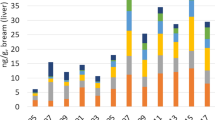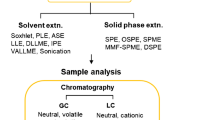Abstract
The present study applies the Hierarchical Technology for Quantitative Structure–Activity Relationships (HiT QSAR) for (i) evaluation of the influence of the characteristics of 28 nitroaromatic compounds (some of which belong to a widely known class of explosives) as to their toxicity; (ii) prediction of toxicity for new nitroaromatic derivatives; (iii) analysis of the effects of substituents in nitroaromatic compounds on their toxicity in vivo. The 50% lethal dose concentration for rats (LD50) was used to develop the QSAR models based on simplex representation of molecular structure. The preliminary 1D QSAR results show that even the information on the composition of molecules reveals the main tendencies of changes in toxicity. The statistic characteristics for partial least squares 2D QSAR models are quite satisfactory (R 2 = 0.96–0.98; Q 2 = 0.91–0.93; R 2 test = 0.89–0.92), which allows us to carry out the prediction of activity for 41 novel compounds designed by the application of new combinations of substituents represented in the training set. The comprehensive analysis of toxicity changes as a function of substituent position and nature was carried out. Molecular fragments that promote and interfere with toxicity were defined on the basis of the obtained models. It was shown that the mutual influence of substituents in the benzene ring plays a crucial role regarding toxicity. The influence of different substituents on toxicity can be mediated via different C–H fragments of the aromatic ring.








Similar content being viewed by others
Notes
Number of groups is a tuning parameter of the model and can be varied.
Abbreviations
- AVS:
-
Automatic variables selection
- DA:
-
Applicability domain
- GA:
-
Genetic algorithm
- HiT QSAR:
-
Hierarchical QSAR technology
- HQSAR:
-
Hologram QSAR approach
- LD50 :
-
50% lethal dose concentration
- PLS:
-
Partial least squares or projection on latent structures statistical method
- Q 2 :
-
Cross-validation determination coefficient
- QSAR/QSPR:
-
Quantitative structure–activity/property relationship
- R 2 :
-
Determination coefficient for training set
- R 2 test :
-
Determination coefficient for test set
- SD:
-
Simplex descriptor
- SiRMS:
-
Simplex representation of molecular structure QSAR approach
- TV:
-
Trend-vector statistical method
References
Johnson LR, Devenport R, Balbach HDJS (1994) Phototoxicology. Comparative toxicity of trinitrotoluene and aminodinitotoluenes to Daphnia magna, Dugesia dorotocephala, and sheep erythrocytes. Ecotoxicol Environ Saf 27:44–49
Donlon BA, Razo-Flores E, Field JA, Lettinga G (1995) Toxicity of N-substituted aromatics to acetoclastic methanogenic activity in granular sludge. Appl Environ Microbiol 61:3889–3893
Slater EC (1962) Mechanism of uncoupling of oxidative phosphorylation by nitrophenols. Comp Biochem Physiol 4:281–301
Nemeikaitė-Čėnienė A, Miliukienė V, Šarlauskas V, Maldutis E, Čėnas N (2006) Chemical aspects of cytotoxicity of nitroaromatic explosives: a review. Chemija 17:34–41
Kuz’min VE, Artemenko AG, Kovdienko NA, Tetko IV, Livingstone DJ (2000) Lattice model for QSAR studies. J Mol Model 6:517–526
Agrawal WK, Khadikar PV (2001) QSAR prediction of toxicity of nitrobenzenes. Bioorg Med Chem 9:3035–3040
Cronin MTD, Schultz TW (2001) Development of quantitative structure-activity relationships for the toxicity of aromatic compounds to Tetrahymena pyriformis: comparative assessment of the methodologies. Chem Res Toxicol 14:1284–1295
Isayev O, Rasulev B, Gorb L, Leszczynski J (2006) Structure-toxicity relationships of nitroaromatic compounds. Mol Divers 10:233–245
Kuz’min VE, Artemenko AG, Polischuk PG, Muratov EN, Hromov AI, Liahovskiy AV, Andronati SA, Makan SY (2005) Hierarchic system of QSAR models (1D–4D) on the base of simplex representation of molecular structure. J Mol Model 11(6):457–467
Kuz’min VE, Artemenko AG, Muratov EN (2007) Hierarchical QSAR technology on the base of Simplex representation of molecular structure. J Comput Aided Mol Des 22 (doi: 10.1007/s10822-008-9179-6)
Kuz’min VE, Artemenko AG, Lozitska RN, Fedtchouk AS, Lozitsky VP, Muratov EN, Mescheriakov AK (2005) Investigation of anticancer activity of macrocyclic Schiff bases by means of 4D-QSAR based on simplex representation of molecular structure. SAR QSAR Environ Res 16(3):219–230
Kuz’min VE, Artemenko AG, Lozitsky VP, Muratov EN, Fedtchouk AS, Dyachenko NS, Nosach LN, Gridina TL, Shitikova LI, Mudrik LM, Mescheriakov AK, Chelombitko VA, Zheltvay AI, Vanden Eynde J-J (2002) The analysis of structure- anticancer and antiviral activity relationships for macrocyclic pyridinophanes and their analogues on the basis of 4D QSAR models (simplex representation of molecular structure). Acta Biochim Pol 49:157–168
Artemenko AG, Muratov EN, Kuz’min VE, Kovdienko NA, Hromov AI, Makarov VA, Riabova OB, Wutzler P, Schmidtke M (2007) Identification of individual structural fragments of N,N′-(bis-5-nitropyrimidyl)dispirotripiperazine derivatives for cytotoxicity and antiherpetic activity allows the prediction of new highly active compounds. J Antimicrob Chemother 60(1):68–77
Kuz’min VE, Artemenko AG, Muratov EN, Volineckaya IL, Makarov VA, Riabova OB, Wutzler P, Schmidtke M (2007) Quantitative structure-activity relationship studies of [(biphenyloxy)propyl]isoxazole derivatives—human rhinovirus 2 replication inhibitors. J Med Chem 50:4205–4213
Muratov E, Artemenko A, Kuz’min V, Konup I, Konup L, Kotlyar S, Kamalov G, Fedtchuk ANM (2006) Computational design of the new antimicrobials based on the substituted crown ethers. Clin Microbiol Infec 12(4):1558
Muratov EN, Artemenko AG, Kuz’min VE, Lozitsky VP, Fedchuk AS, Lozitska RN, Boschenko YA, Gridina TL (2005) Investigation of anti-influenza activity using hierarchic QSAR technology on the base of simplex representation of molecular structure. Antiviral Res 65(3):A62–A63
Zhang S, Golbraikh A, Oloff S, Kohn H, Tropsha A (2006) A novel automated lazy learning QSAR (ALL-QSAR) approach: method development, applications, and virtual screening of chemical databases using validated ALL-QSAR models. J Chem Inf Model 46:1984–1995
Kuz’min VE (1995) About homo- and heterochirality of dissymetrical tetrahedrons (chiral simplexes). Stereochemical tunneling. Zh Strucur Khim 36:873–878
Jolly WL, Perry WB (1973) Estimation of atomic charges by an electronegativity equalization procedure calibration with core binding energies. J Am Chem Soc 95:5442–5450
Wang R, Fu Y, Lai L (1997) A new atom–additive method for calculating partition coefficients. J Chem Inf Comp Sci 37:615–621
Rappe AK, Casewit CJ, Colwell KS, Goddart WA, Skiff WM (1992) UFF, a full periodic table force field for molecular mechanics and molecular dynamics simulations. J Am Chem Soc 114:10024–10035
Kubinyi H (1996) Evolutionary variable selection in regression and PLS analyses. J Chemometrics 10:119–133
Lindgren F, Geladi P, Rannar S, Wold S (1994) Interactive variable selection (IVS) for PLS. Part 1: theory and algorithms. J Chemometrics 8:349–363
Rannar S, Lindgren F, Geladi P, Wold S (1994) A PLS kernel algorithm for data sets with many variables and fewer objects. Part 1: theory and algorithm. J Chemometrics 8:111–125
Hasegawa K, Miyashita Y, Funatsu K (1997) GA strategy for variable selection in QSAR studies: GA-based PLS analysis of calcium channel antagonists. J Chem Inf Comput Sci 37:306–310
Carhart RE, Smith DH, Venkataraghavan R (1995) Atom pairs as molecular features in structure—activity studies. Definition and application. J Chem Inf Comput Sci 25:64–73
Jaworska J, Nikolova-Jeliazkova N, Aldenberg T (2005) QSAR applicability domain estimation by projection of the training set in descriptor space: a review. Altern Lab Anim 33:445–459
Gramatica P (2004) Evaluation of different statistical approaches for the validation of quantitative structure–activity relationships. ECVAM, Ispra, p 177
Tropsha A, Gramatica P, Gombar VK (2003) The importance of being earnest: validation is the absolute essential for successful application and interpretation of QSPR models. QSAR Comb Sci 22:69–77
QSAR; Expert; Group (2004) The report from the expert group on (Quantitative) Structure–Activity Relationships [(Q)SARs] on the principles for the validation of (Q)SARs.; 49; Organisation for Economic Co-operation and Development, Paris, p 206
Harvey DG (1959) On the metabolism of some aromatic nitro compounds by different species of animal. III. The toxicity of the dinitrophenols, with a note on the effects of high environmental temperatures. J Pharm Pharmacol 11:462–474
Sziza M, Magos L (1959) Toxicologic investigation of some aromatic nitrogen compounds approved for use in Hungarian industry. Arch Gewerbepathol Gewerbehyg 17:217–226
Wyman JF, Serve MP, Hobson DW, Lee LH, Uddin DE (1992) Acute toxicity, distribution, and metabolism of 2,4,6-trinitrophenol (picric acid) in Fischer 344 rats. J Toxicol Environ Health 37(2):313–327
Harvey DG (1953) The toxicity of the dinitrocresols. II. The formation and toxic properties of some nitrocompounds derived from meta- and para- cresols. J Pharm Pharmacol 8:497–510
Cramer GM, Ford RA, Hall RL (1978) Estimation of toxic hazard—a decision tree approach. J Cosmet Toxicol 16:255–276
Hakimelahi GH, Khodarahmi GA (2005) The identification of toxicophores for the prediction of mutagenicity, hepatotoxicity and cardiotoxicity. J Iran Chem Soc 2:244–267
Kazius J, McGuire R, Bursi R (2005) Derivation and validation of toxicophores for mutagenicity prediction. J Med Chem 48(1):312–320
Kuz’min VE, Artemenko AG, Muratov EN, Lozitsky VP, Fedchuk AS, Lozitska RN, Boschenko YA, Gridina TL (2005) The hierarchical QSAR technology for effective virtual screening and molecular design of the promising antiviral compounds. Antiviral Res 65(3):A70–A71
Acknowledgments
We appreciate and thank Dr. John Cullinane, ERDC Technical Director for Military Environmental Engineering and Science and Dr. Richard E. Price, Environmental Division Chief, ERDC, for their support and encouragement. Permission was granted by the Chief of Engineers to publish this information. This content does not necessarily reflect the position or the policy of the government, and no official endorsement should be inferred. The authors are also thankful to Drs. B. Rasulev, A. Toropov and O. Isaev for fruitful discussion and useful comments.
Funding
US Army Environmental Quality Technology Program (grant W912Z-04-P-139) administrated by the US Army Engineer Research and Development Center; US Army Engineer Research and Development Center CMCM program (grant 2T346GM007672-25A1). The authors confirm independence from the sponsors; the content of the article has not been influenced by the sponsors.
Author information
Authors and Affiliations
Corresponding author
Electronic supplementary material
Below is the link to the electronic supplementary material.
Rights and permissions
About this article
Cite this article
Kuz’min, V.E., Muratov, E.N., Artemenko, A.G. et al. The effects of characteristics of substituents on toxicity of the nitroaromatics: HiT QSAR study. J Comput Aided Mol Des 22, 747–759 (2008). https://doi.org/10.1007/s10822-008-9211-x
Received:
Accepted:
Published:
Issue Date:
DOI: https://doi.org/10.1007/s10822-008-9211-x




